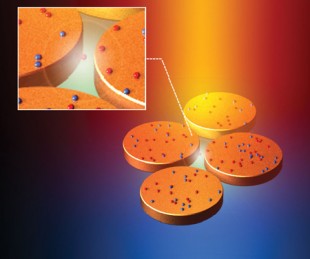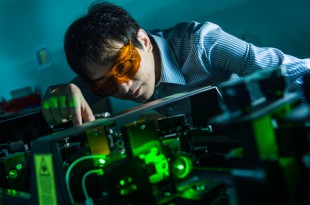David Ruth
713-348-6327
david@rice.edu
Jade Boyd
713-348-6778
jadeboyd@rice.edu
Rice nanophotonics experts create powerful molecular sensor
Sensor amplifies optical signature of single molecules about 100 billion times
HOUSTON — (July 15, 2014) — Nanophotonics experts at Rice University have created a unique sensor that amplifies the optical signature of molecules by about 100 billion times. Newly published tests found the device could accurately identify the composition and structure of individual molecules containing fewer than 20 atoms.
The new imaging method, which is described this week in the journal Nature Communications, uses a form of Raman spectroscopy in combination with an intricate but mass reproducible optical amplifier. Researchers at Rice’s Laboratory for Nanophotonics (LANP) said the single-molecule sensor is about 10 times more powerful that previously reported devices.

Rice's SECARS molecular sensor contains an optical amplifier made of four gold discs arranged in a diamond-shaped pattern. A two-coherent-laser setup amplifies the optical signatures of molecules in the center of the structure as much as 100 billion times. Credit: Y. Zhang/Rice University
“Ours and other research groups have been designing single-molecule sensors for several years, but this new approach offers advantages over any previously reported method,” said LANP Director Naomi Halas, the lead scientist on the study. “The ideal single-molecule sensor would be able to identify an unknown molecule — even a very small one — without any prior information about that molecule’s structure or composition. That’s not possible with current technology, but this new technique has that potential.”
The optical sensor uses Raman spectroscopy, a technique pioneered in the 1930s that blossomed after the advent of lasers in the 1960s. When light strikes a molecule, most of its photons bounce off or pass directly through, but a tiny fraction — fewer than one in a trillion — are absorbed and re-emitted into another energy level that differs from their initial level. By measuring and analyzing these re-emitted photons through Raman spectroscopy, scientists can decipher the types of atoms in a molecule as well as their structural arrangement.
Scientists have created a number of techniques to boost Raman signals. In the new study, LANP graduate student Yu Zhang used one of these, a two-coherent-laser technique called “coherent anti-Stokes Raman spectroscopy,” or CARS. By using CARS in conjunction with a light amplifier made of four tiny gold nanodiscs, Halas and Zhang were able to measure single molecules in a powerful new way. LANP has dubbed the new technique “surface-enhanced CARS,” or SECARS.
“The two-coherent-laser setup in SECARS is important because the second laser provides further amplification,” Zhang said. “In a conventional single-laser setup, photons go through two steps of absorption and re-emission, and the optical signatures are usually amplified around 100 million to 10 billion times. By adding a second laser that is coherent with the first one, the SECARS technique employs a more complex multiphoton process.”
Zhang said the additional amplification gives SECARS the potential to address most unknown samples. That’s an added advantage over current techniques for single-molecule sensing, which generally require a prior knowledge about a molecule’s resonant frequency before it can be accurately measured.
Another key component of the SECARS process is the device’s optical amplifier, which contains four tiny gold discs in a precise diamond-shaped arrangement. The gap in the center of the four discs is about 15 nanometers wide. Owing to an optical effect called a “Fano resonance,” the optical signatures of molecules caught in that gap are dramatically amplified because of the efficient light harvesting and signal scattering properties of the four-disc structure.
Fano resonance requires a special geometric arrangement of the discs, and one of LANP’s specialties is the design, production and analysis of Fano-resonant plasmonic structures like the four-disc “quadrumer.” In previous LANP research, other geometric disc structures were used to create powerful optical processors.
Zhang said the quadrumer amplifiers are a key to SECARS, in part because they are created with standard e-beam lithographic techniques, which means they can be easily mass-produced.
“A 15-nanometer gap may sound small, but the gap in most competing devices is on the order of 1 nanometer,” Zhang said. “Our design is much more robust because even the smallest defect in a one-nanometer device can have significant effects. Moreover, the larger gap also results in a larger target area, the area where measurements take place. The target area in our device is hundreds of times larger than the target area in a one-nanometer device, and we can measure molecules anywhere in that target area, not just in the exact center.”
Halas, the Stanley C. Moore Professor in Electrical and Computer Engineering and a professor of biomedical engineering, chemistry, physics and astronomy at Rice, said the potential applications for SECARS include chemical and biological sensing as well as metamaterials research. She said scientific labs are likely be the first beneficiaries of the technology.
“Amplification is important for sensing small molecules because the smaller the molecule, the weaker the optical signature,” Halas said. “This amplification method is the most powerful yet demonstrated, and it could prove useful in experiments where existing techniques can’t provide reliable data.”
Study co-authors include Yu-Rong Zhen, Oara Neumann, Jared Day and Peter Nordlander, all of Rice. The research was supported by the Department of Defense, the Defense Threat Reduction Agency and the Robert A. Welch Foundation.
-30-
High-resolution IMAGES are available for download at:
http://news2.rice.edu/files/2014/07/0714_NATCOM-cutaway-lg.jpg
CAPTION: Rice’s SECARS molecular sensor contains an optical amplifier made of four gold discs arranged in a diamond-shaped pattern. A two-coherent-laser setup amplifies the optical signatures of molecules in the center of the structure as much as 100 billion times.
CREDIT: Y. Zhang/Rice University
http://news2.rice.edu/files/2014/07/0714_NATCOM-Yu-lg.jpg
CAPTION: Yu Zhang
CREDIT: Jeff Fitlow/Rice University
A copy of the Nature Communications paper is available at:
http://www.nature.com/ncomms/2014/140714/ncomms5424/full/ncomms5424.html
Located on a 300-acre forested campus in Houston, Rice University is consistently ranked among the nation’s top 20 universities by U.S. News & World Report. Rice has highly respected schools of Architecture, Business, Continuing Studies, Engineering, Humanities, Music, Natural Sciences and Social Sciences and is home to the Baker Institute for Public Policy. With 3,920 undergraduates and 2,567 graduate students, Rice’s undergraduate student-to-faculty ratio is just over 6-to-1. Its residential college system builds close-knit communities and lifelong friendships, just one reason why Rice has been ranked No. 1 for best quality of life multiple times by the Princeton Review and No. 2 for “best value” among private universities by Kiplinger’s Personal Finance. To read “What they’re saying about Rice,” go here.


